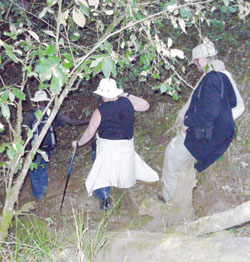By Kassim Shitawa
After traversing the Samburu National Reserve, we camped and decided to head to the sacred mountain, Mt Olololokwe, situated in the expansive Namunyak Wildlife Conservation. We took a last look at the unique fauna before checking out of the reserve and heading to Archers Post shopping centre.
It is a one-street town with shops lining both sides of the road. Samburu young men resplendent in their colourful traditional attire roamed aimlessly down the town’s main street. Samburu old men huddled in groups conversing or playing the ajua game, occasionally sniffing tobacco powder and sneezing heavily. To my surprise, I saw one of them sneeze and wipe his running nose with his bare palm. He then spat his phlegm and resumed the game unperturbed!
 |
Tourists descend a mountain while on their hike. Photos: Courtesy |
We were planning to hike up Mt Olololokwe, which looked so vertical we wondered how we would make it up. That night, we enjoyed a sumptuous dinner prepared by our safari cook, then drifted off to sleep amid sounds of hyenas and the constant humming and buzzing of crickets and other nocturnal insects.
The following morning, we woke up to find donkeys at the campsite. Our guides informed us they were intended for the journey, so we packed our provisions on top of them and set off. Lesepe showed us fresh prints on the ground and informed us that a leopard had wandered close to our camp at night. That revelation sent a chill down our spines, although the guides assured us wild animals rarely attacked tents.
warrior songs
About an hour later, we set off, leaving the driver and one of the rangers at the campsite to watch over the car and some of our belongings. In single file, Lesepe led the pack while Katarini (the game ranger) and the donkeys were last. Hiking steadily, we traversed through the magnificent comiphora, cicus, juniper and podo carpus forests, stopping every 10 to 15 minutes to catch our breaths and enjoy the landscape.
Generally, the first two hours of the hike are the most difficult because the gradient is very steep but, as soon as we got to the first clearing, our breath was taken away by the generous view of the "mountain of the wild goats". Steppe plains spread all the way to Laisamis. Lesepe pointed out two rocks that the locals refer to as cat and mouse, which intriguingly, are shaped exactly as named!
We made a rest stop at this clearing, and the tourists took the opportunity to apply generous sunscreen on their faces and other exposed parts of their bodies. The rest of us with ‘hardy’ skins watched in amusement.
A few minutes later, we continued with the hike. The terrain was gentler and the occasional breeze refreshing. Katarini broke into a Samburu warrior song and we walked to its rhythm. We came across makeshift manyattas but there was no soul in sight. Suddenly, we heard voices singing in unison and the distant mooing of cattle. Laden with curiosity, we hastened our steps towards the singing.
As we approached what seemed like a dry riverbed, the singing grew louder as did the mooing of cattle. Though we could hear several voices singing, we only saw one Samburu herdsman rhythmically fetching water into a trough. When we moved closer, we realised there were see three other herdsmen down the hole. One scooped out the water and passed it to the second man who in turn passed it to the third and finally to the fourth herdsman outside.
sacrifices to the gods
Stay informed. Subscribe to our newsletter
We stood still and marvelled at the sight. The music was so melodious that the tourists wanted to record it but the herdsmen refused. We reluctantly moved on. Two hours later, we reached the campsite, hot, tired and hungry. We had lunch under the pencil cedar trees and lay down on hard-rock surface, our daypacks serving as pillows.
Afterwards, we set up camp and took a leisurely walk to the summit viewpoints. We startled a family of baboons who scampered away in fear. Other than numerous pied crows and elephant droppings, we did not see any other wild animals. Lesepe explained that elephants stayed on the mountain only in the rainy season.
Since the summit is forested, we were unable to see much so we descended to the south-eastern side for a better view. At the edge of one cliff, we were treated to a spectacular view of the Conservation. The most outstanding view was of the magnificent Mathew Ranges with its Warges peak standing out in defiance. Further south in the distance, we saw an outline of the Nyambene Hills in Meru.
On our way back to the campsite, we came across Samburu morans eating meat in seclusion. They had come here to learn the traditions and customs of their tribe. On other sites of the mountain, Lesepe revealed there were elders who had come to pray. Often, just before a catastrophe or a major event like circumcision, the elders came to the mountain to offer sacrifices to the gods.
 The Standard Group Plc is a
multi-media organization with investments in media platforms spanning newspaper
print operations, television, radio broadcasting, digital and online services. The
Standard Group is recognized as a leading multi-media house in Kenya with a key
influence in matters of national and international interest.
The Standard Group Plc is a
multi-media organization with investments in media platforms spanning newspaper
print operations, television, radio broadcasting, digital and online services. The
Standard Group is recognized as a leading multi-media house in Kenya with a key
influence in matters of national and international interest.
 The Standard Group Plc is a
multi-media organization with investments in media platforms spanning newspaper
print operations, television, radio broadcasting, digital and online services. The
Standard Group is recognized as a leading multi-media house in Kenya with a key
influence in matters of national and international interest.
The Standard Group Plc is a
multi-media organization with investments in media platforms spanning newspaper
print operations, television, radio broadcasting, digital and online services. The
Standard Group is recognized as a leading multi-media house in Kenya with a key
influence in matters of national and international interest.









